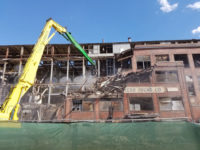When a buried oil pipeline at a station on the Trans Alaska Pipeline System sprung a leak, the pipeline company faced a costly problem: Scrap the piping below ground and rebuild above ground or find technology that could inspect the original line.
The line’s structural integrity could be assessed using pipeline inspection gauges, or “pigs,” which are cleaning devices— smart pigs have sensors—that are inserted into an oversized section of pipe, called a launching station, and pushed by the oil flow to a receiving station.
“But these lines were relief lines at the pump stations and weren’t accessible to run a wet pig,” says Daniel Williamson, project manager, Alyeska Pipeline Service Co., Anchorage. Without a known technology that could do the task, Williamson and his team began designing to bring the pipes above ground, an operation that he says would have been costly.
Two years into the design, Bhaskar Neogi, director of risk and compliance, Alyeska, found a tech solution called RODIS, or “remotely operated diagnostic inspection system,” created by Diakont, St. Petersburg, Russia. He really wanted to avoid replacing the pipes. “Steel with corrosion prevention does not degrade over time, so this replacement would only accomplish the ability to inspect piping in the above ground mode,” says Neogi. The next problem was that RODIS wasn’t designed for use in a liquid but a natural-gas pipeline.
To ensure it could work on their pipes, Alyeska ran tests on a similar out-of commission line and found that RODIS would work, but the pipes had to be squeaky clean, says Williams. “We cleaned them ourselves on the first project but eventually hired a subcontractor,” he says. The Houston-based subcontractor Aquadrill International used an advanced pipe-cleaning system comprising a hose and a dispersal attachment that, together, emit jets of highly pressurized water. Once cleaned, RODIS was sent in to inspect all of the piping that was otherwise unreachable.
“The RODIS crawler we’re using has three sensor mechanisms it uses to get a total picture of the pipe condition,” says Neogi. The first is a high definition camera that shows a visual representation of the internal pipe wall. The second is a laser scanner that can map the profile of the internal pipe wall surface. Finally, an electromagnetic acoustic transducer is used to measure internal and external wall loss. The tool provides real-time measurements and is tethered back to Diakont inspectors who interpret signals from these instruments and determine the condition of the pipe. Williams says RODIS has been successful on three Alyeska pipelines and saved the project $70 million. The results allowed the company to leave undamaged pipes alone, apply protective coating to the inside of pipes that needed it, and replace sections of pipes that had anomalies that couldn’t be treated otherwise. The company will likely use it on more sections next year.
“This is a case of the regulations working,” Lois Epstein, president of Pipeline Safety Trust, headquartered in Anchorage. The U.S. Dept. of Transportation Pipeline and Hazardous Materials Safety Administration required inspections of not only Alyeska but all pipeline companies, Epstein says.
When regulations were put in place, there was pushback from some companies. The argument was that, since their lines were designed before pigs, the regulations shouldn’t apply, Epstein says. “The pushback—while real at the time—wasn’t appropriate in the long run. The goal was to prevent future leaks,” she says.
With RODIS to the rescue, the regulations aren’t as costly as companies feared.




Post a comment to this article
Report Abusive Comment